Pas de biographie disponible.
Compositeur Musique additionelle Librettiste Parolier Metteur en scène Chorégraphe Producteur création Producteur version
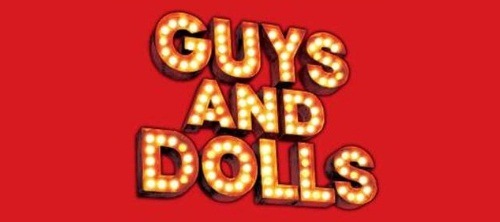
Musical
Musique: Frank Loesser • Paroles: Frank Loesser • Livret: Abe Burrows • Jo Swerling • Production originale: 16 versions mentionnées
Dispo: Résumé Synopsis Génèse Isnpiration Liste chansons
Vidéos:
Genèse: Background Guys and Dolls was conceived by producers Cy Feuer and Ernest Martin as an adaptation of Damon Runyon's short stories. These stories, written in the 1920s and 1930s, concerned gangsters, gamblers, and other characters of the New York underworld. Runyon was known for the unique dialect he employed in his stories, mixing highly formal language and slang. Frank Loesser, who had spent most of his career as a lyricist for movie musicals, was hired as composer and lyricist. George S. Kaufman was hired as director. When the first version of the show's book, written by Jo Swerling, was deemed unusable, Feuer and Martin asked radio comedy writer Abe Burrows to write a new version of the book. Loesser had already written much of the score to correspond with the first version of the book. Burrows later recalled, "Frank Loesser's fourteen songs were all great, and the [new book] had to be written so that the story would lead into each of them. Later on, the critics spoke of the show as 'integrated'. The word integration usually means that the composer has written songs that follow the story line gracefully, Well, we accomplished that but we did it in reverse". The character of Miss Adelaide was created specifically to fit Vivian Blaine into the musical, after Loesser decided she was ill-suited to play the conservative Sarah.[8] When Loesser suggested reprising some songs in the second act, Kaufman warned: "If you reprise the songs, we’ll reprise the jokes." Original productions The musical premiered on Broadway at the 46th Street Theatre on November 24, 1950. It was directed by George S. Kaufman, with dances and musical numbers by Michael Kidd, scenic and lighting design by Jo Mielziner, costumes by Alvin Colt, and orchestrations by George Bassman and Ted Royal, with vocal arrangements by Herbert Greene. It starred Robert Alda, Sam Levene, Isabel Bigley, and Vivian Blaine. Iva Withers was a replacement as Adelaide. The musical ran for 1.200 performances, winning five 1951 Tony Awards, including the award for Best Musical. Decca Records issued the original cast recording on 78 rpm records, which was later expanded and re-issued on LP, and then transferred to CD in the 1980s. The West End premiere opened at the London Coliseum on May 28, 1953 and ran for 555 performances. The cast starred Vivian Blaine, Sam Levene, Lizbeth Webb and Jerry Wayne. Lizbeth Webb was the only major principal who was British and was chosen to play the part of Sarah Brown by Frank Loesser. The show has had numerous revivals and tours and has become a popular choice for school and community theatre productions. New York City Center 1955, 1965 and 1966 revivals New York City Center mounted short runs of the musical in 1955, 1965 and 1966. A production starring Walter Matthau as Nathan Detroit, Helen Gallagher as Adelaide, Ray Shaw as Sky and Leila Martin as Sarah had 31 performances, running from April 20 to May 1, and May 31 to June 12, 1955. Another presentation at City Center, with Alan King as Nathan Detroit, Sheila MacRae as Adelaide, Jerry Orbach as Sky and Anita Gillette as Sarah, ran for 15 performances from April 28 to May 9, 1965. A 1966 production, starring Jan Murray as Nathan Detroit, Vivian Blaine reprising her role as Adelaide, Hugh O'Brian as Sky, and Barbara Meister as Sarah, ran for 23 performances, from June 8 to June 26, 1966. 1976 Broadway revival Libretto and vocal book, Music Theatre International (1978), rented out to actors.An all-black cast staged the first Broadway revival of the show, which opened on July 11, 1976 in previews, officially on July 21, at The Broadway Theatre. It starred Robert Guillaume as Nathan Detroit, Norma Donaldson as Miss Adelaide, James Randolph as Sky and Ernestine Jackson as Sarah Brown. Guillaume and Jackson were nominated for Tony and Drama Desk Awards, and Ken Page as Nicely-Nicely won a Theatre World Award. This production featured Motown-style musical arrangements by Danny Holgate and Horace Ott, and it was directed and choreographed by Billy Wilson. The entire production was under the supervision of Abe Burrows, and musical direction and choral arrangements were by Howard Roberts. The show closed on February 13, 1977 after 239 performances and 12 previews. A cast recording was released subsequent to the show's opening. 1982 London revival Laurence Olivier had wanted to play Nathan Detroit, and began rehearsals for a planned 1971 London revival of Guys and Dolls at his National Theatre Company's Old Vic theatre. However, due to poor health he had to stop, and his revival never saw the light of day. In 1982, Richard Eyre directed a major revival at London's National Theatre. Eyre called it a "re-thinking" of the musical, and his production featured an award-winning neon-lit set design inspired by Rudi Stern's 1979 book Let There Be Neon, and brassier orchestrations with vintage yet innovative harmonies. The show's choreography by David Toguri included a large-scale tap dance number of the "Guys and Dolls" finale, performed by the principals and entire cast. The revival opened March 9, 1982, and was an overnight sensation, running for nearly four years and breaking all box office records. The original cast featured Bob Hoskins as Nathan Detroit, Julia McKenzie as Adelaide, Ian Charleson as Sky and Julie Covington as Sarah. The production won five Olivier Awards, including for McKenzie and Eyre and for Best Musical. Eyre also won the Evening Standard Award, and Hoskins won the Critics' Circle Theatre Award. In October 1982, Hoskins was replaced by Trevor Peacock, Charleson by Paul Jones, and Covington by Belinda Sinclair; in the spring of 1983 McKenzie was replaced by Imelda Staunton and Fiona Hendley replaced Sinclair. This production closed in late 1983 to make way for a Broadway try-out of the ill-fated musical Jean Seberg, which following critical failure closed after four months. Eyre's Guys and Dolls returned to the National from April through September 1984, this time starring Lulu, Norman Rossington, Clarke Peters and Betsy Brantley. After a nationwide tour, this production transferred to the West End at the Prince of Wales Theatre, where it ran from June 1985 to April 1986. Following Ian Charleson's untimely death from AIDS at the age of 40, in November 1990 two reunion performances of Guys and Dolls, with almost all of the original 1982 cast and musicians, were given at the National Theatre as a tribute to Charleson. The tickets sold out immediately, and the dress rehearsal was also packed. The proceeds from the performances were donated to the new Ian Charleson Day Centre HIV clinic at the Royal Free Hospital, and to scholarships in Charleson's name at LAMDA. 1992 Broadway revival DVD cover of the 1992 cast-album recording documentary, Guys and Dolls: Off the Record, starring Peter Gallagher, Josie de Guzman, Nathan Lane, and Faith PrinceThe 1992 Broadway revival was the most successful American remounting of the show since its original opening. Directed by Jerry Zaks, it starred Nathan Lane as Nathan Detroit, Peter Gallagher as Sky, Faith Prince as Adelaide and Josie de Guzman as Sarah. This production played at the Martin Beck Theatre from April 14, 1992 to January 8, 1995, with 1,143 performances. The production received a rave review from Frank Rich in The New York Times, stating "It's hard to know which genius, and I do mean genius, to celebrate first while cheering the entertainment at the Martin Beck." It received eight Tony Award nominations, and won four, including Best Revival of a Musical, and the show also won the Drama Desk Award for Outstanding Revival. This revival featured various revisions to the show's score, including brand new music for the "Runyonland", "A Bushel and a Peck," "Take Back Your Mink" and "Havana". The orchestrations were redesigned by Michael Starobin, and there were new dance arrangements added to "A Bushel and a Peck" and "Take Back Your Mink". A one-hour documentary film captured the recording sessions of the production's original cast album. Titled Guys and Dolls: Off the Record, the film aired on PBS's Great Performances series in December 1992, and was released on DVD in 2007. Complete takes of most of the show's songs are featured, as well as coaching from director Zaks, and commentary sessions by stars Gallagher, de Guzman, Lane, and Prince on the production and their characters. 1996 London revival Richard Eyre repeated his 1982 success with another National Theatre revival of the show, this time in a limited run. It starred Henry Goodman as Nathan Detroit, Imelda Staunton returning as Adelaide, Clarke Peters returning as Sky and Joanna Riding as Sarah. Clive Rowe played Nicely-Nicely Johnson, and David Toguri returned as choreographer. The production ran from December 17, 1996 through March 29, 1997 and from July 2, 1997 to 22 November 22, 1997.[33][34] It received three Olivier Award nominations, winning one: Best Supporting Performance in a Musical went to Clive Rowe. Richard Eyre won the Critics' Circle Theatre Award for Best Director, and the production won Best Musical. 2005 West End revival The 2005 West End revival opened at London's Piccadilly Theatre in June 2005 and closed in April 2007. This revival, directed by Michael Grandage, starred Ewan McGregor as Sky, Jenna Russell as Sarah, Jane Krakowski as Adelaide, and Douglas Hodge as Nathan Detroit. During the run, Nigel Harman, Adam Cooper, Norman Bowman and Ben Freeman took over as Sky; Kelly Price, Amy Nuttall and Lisa Stokke took over as Sarah; Sarah Lancashire, Sally Ann Triplett, Claire Sweeney and Samantha Janus took over as Adelaide; and Nigel Lindsay, Neil Morrissey, Patrick Swayze, Alex Ferns and Don Johnson took over as Nathan Detroit. This production added the song "Adelaide" that Frank Loesser had written for the 1955 film adaptation. According to a September 2007 article in Playbill.com, this West End production had been scheduled to begin previews for a transfer to Broadway in February 2008, but this plan was dropped. 2009 Broadway revival A 2009 Broadway revival of the show opened on March 1, 2009 at the Nederlander Theatre. The cast starred Oliver Platt as Nathan Detroit, Lauren Graham, in her Broadway debut, as Adelaide, Craig Bierko as Sky and Kate Jennings Grant as Sarah. Des McAnuff was the director, and the choreographer was Sergio Trujillo. The show opened to generally negative reviews. The New York Times called it "static" and "uninspired", the New York Post said, "How can something so zippy be so tedious?" and Time Out New York wrote, "Few things are more enervating than watching good material deflate." However, the show received a highly favorable review from The New Yorker, and the producers decided to keep the show open in hopes of positive audience response. The New York Post reported on March 4 that producer Howard Panter "[said] he'll give Guys and Dolls at least seven weeks to find an audience." The revival closed on June 14, 2009 after 28 previews and 113 performances.
Résumé: Desperate to find money to pay for his floating crap game, Nathan Detroit bets Sky Masterson a thousand dollars that Sky will not be able to take a local Salvation Army girl, Sarah Brown, to Cuba. While Sky eventually is able to convince Sarah to join him, Nathan battles with his fiancé of fourteen years, Adelaide. Meanwhile in Cuba, Sky ends up falling in love with Sarah and tries to reform his gambling ways. When he returns back to New York, he bets all the members of the floating crap game that if he wins his roll of the dice, they will all have to go to church and repent. If he loses, he will give them each a thousand dollars. He ends up winning and all the gamblers end up visiting the mission and repenting their sins. Dancing in this show requires jazz and showdance. Read more: http://www.stageagent.com/Shows/View/711#ixzz2UKNtjUZ2
Création: 24/11/1950 - Richard Rodgers Theatre (Broadway) - représ.
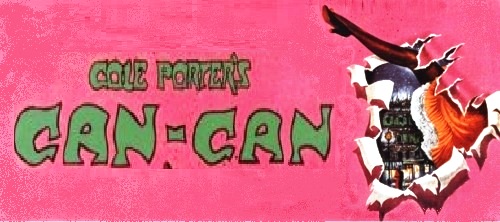
Musical
Musique: Cole Porter • Paroles: Cole Porter • Livret: Abe Burrows • Production originale: 13 versions mentionnées
Dispo: Résumé Synopsis Commentaire Génèse Liste chansons
Genèse: After the pre-Broadway tryout at the Shubert Theatre in Philadelphia in March 1953, Can-Can premiered on Broadway at the Shubert Theatre on May 7, 1953, and closed on June 25, 1955 after 892 performances. The original production, which Burrows also directed, starred Lilo as La Mome, Hans Conried as Boris, Peter Cookson as the judge, Gwen Verdon as Claudine, Dania Krupska, Phil Leeds, Dee Dee Wood, and Erik Rhodes as Hilaire. Michael Kidd was the choreographer. According to Ben Brantley, Claudine was "the part that made Gwen Verdon a star." The West End production premiered at the Coliseum Theatre on October 14, 1954, and ran for 394 performances. Restaged by Jerome Whyte, the cast included Irene Hilda (La Mome), Edmund Hockridge (Aristide), Alfred Marks (Boris), Gillian Lynne (Claudine) and Warren Mitchell (Theophile). A Broadway revival opened April 30, 1981 at the Minskoff Theatre and closed after five performances and sixteen previews. It was directed by Burrows with choreography by Roland Petit and starred Zizi Jeanmaire. Frank Rich wrote: "...mediocre material, no matter how it's sliced, is still mediocre material. 'Can-Can' never was a firstrate musical, and now, almost three decades after its original production, it stands on even shakier legs." A 1983 outdoor production played at The Muny in St. Louis, starring Judy Kaye, John Reardon, John Schuck, Lawrence Leritz, Lorene Yarnell and Beth Leavel to excellent reviews. The London revival at the Strand Theatre ran from October 26, 1988 through January 21, 1989. David Taylor directed, with choreography by Kenn Oldfield, with a cast that featured Donna McKechnie (Mme. Pistache), Bernard Alane, Norman Warwick, Janie Dee (Claudine) and Milo O'Shea. Producer Lovett Bickford explained that "his version was less a revival than a complete revision. 'For all intents and purposes, this is a new show,' he said."[6] It had a revised book which incorporated songs from Fifty Million Frenchmen, Nymph Errant, Silk Stockings, Out of This World and other Cole Porter musicals. Also in 1988, an international tour starred Chita Rivera and Ron Holgate. The tour featured the Radio City Music Hall Rockettes. This production was directed by Dallett Norris, with choreography by Alan Johnson.[7] In 2004, a City Center Encores! staged concert production featured Patti LuPone as La Mome Pistache, Michael Nouri (Judge Aristide Forestier), Charlotte d'Amboise (Claudine), Reg Rogers, and Eli Wallach. This production was directed by Lonny Price, with sets by John Lee Beatty and lighting by Kenneth Posner.
Résumé: Au tournant du siècle, à Paris, La Mome Pistache, fière propriétaire de l'infâme "Bal du Paradis", affronte Aristide Forestier, un juge extrêmement rigoureux qui a pour but de fermer tous les cabarets parisiens. Par hasard, ils tombent amoureux et Aristide avoue qu'il n'y a obscénité que dans le fait de celui qui regarde…
Création: 7/5/1953 - Shubert Theatre (Broadway) - représ.

Musical
Musique: Cole Porter • Paroles: Cole Porter • Livret: Abe Burrows • George S. Kaufman • Laureen MacGrath • Production originale: 2 versions mentionnées
Dispo: Résumé Liste chansons
Silk Stockings est un musical avec un livret de George S. Kaufman, Leueen MacGrath et Abe Burrows et une musique et des paroles de Cole Porter. Le musical est vaguement basé sur l'histoire de Melchior Lengyel, Ninotchka, et l'adaptation cinématographique qu'elle a inspirée en 1939. Il a été diffusé à Broadway en 1955. Ce fut le dernier comédie musical que Porter a écrit pour la scène.
Genèse:
Résumé: Silk Stockings se déroule principalement à Paris, la ville de comédie musicale préférée de Cole Porter. Trois agents russes, Ivanov, Brankov et Bibinski sont envoyés là-bas pour récupérer le plus grand compositeur russe Peter Ilyich Boroff des voies détournées du capitalisme, mais bientôt les agents eux-mêmes sont enchantés par le mode de vie de l’Occident décadent. Quand Ninotchka reçoit l’ordre de Moscou de les ramener tous au pays, elle tombe elle aussi sous le charme de Paris et des bas de soie, et se retrouve amoureuse de l’agent de cinéma américain Steve Canfield, qui veut utiliser la musique de Boroff dans un futur film mettant en vedette Janice Dayton ancienne reine des films de "belles en maillot de abin" aux États-Unis qui veut maintenant passer à des films dramatiqueq avec une version musicale de Guerre et Paix. Inutile de dire que tout finit bien et que les agents russes ainsi que Boroff et Ninotchka se retrouvent du côté ouest du rideau de fer.
Création: 24/2/1955 - Imperial Theatre (Broadway) - 478 représ.
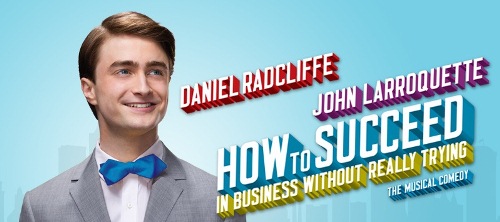
Musical
Musique: Frank Loesser • Paroles: Frank Loesser • Livret: Abe Burrows • Production originale: 8 versions mentionnées
Dispo: Résumé Synopsis Génèse Liste chansons
Genèse: In 1952, Shepherd Mead's satirical book, How to Succeed in Business Without Really Trying, became a bestseller. Playwright Willie Gilbert and fellow playwright Jack Weinstock created a dramatic interpretation in 1955 that was unproduced for five years. Agent Abe Newborn brought the work to the attention of producers Cy Feuer and Ernest Martin, with the intention of retooling it as a musical. Feuer and Martin had great success with the 1950 adaptation of Guys and Dolls and brought in the creative team from that show to work on How to.... Abe Burrows and Frank Loesser set to work on the new adaptation, with rehearsals beginning in August 1961. Burrows collaborated on the book with Jack Weinstock and Willie Gilbert, also serving as director. Their new adaptation became even more satirical and added romance to the story. Loesser wrote both music and lyrics for the show, which was orchestrated by Robert Ginzler. The original Broadway production credited the choreography to an obscure dance director named Hugh Lambert, while the much better-known Bob Fosse received only a "musical staging by..." credit. Abe Burrows explains this in his autobiography Honest, Abe. While How to Succeed... was in its early development, producer Cy Feuer attended a trade show and was extremely impressed by an elaborate dance number created by Lambert, prompting Feuer to hire Lambert to choreograph the new musical. According to Burrows, it soon became clear in rehearsals that Lambert's creative abilities were completely used up in that one elaborate dance number. Bob Fosse was brought in to replace him, but Fosse was unwilling to hurt Lambert's career by having him fired. Lambert's trade-show dance number was recycled as the "Treasure Hunt" dance in How to Succeed..., while Fosse agreed to take a "musical staging" credit for choreographing all the other dance numbers. Burrows also reveals that another crisis arose in rehearsals when former recording star Rudy Vallee wanted to interpolate some of his hit songs from the 1930s. Broadway (1961-1965) The show opened on Broadway on October 14, 1961 at the 46th Street Theatre, and closed on March 6, 1965 after 1,417 performances. The cast starred Robert Morse as Finch, Bonnie Scott as his secretary Rosemary, Charles Nelson Reilly as Bud Frump, and Rudy Vallee as the company president. Virginia Martin played Hedy LaRue. West End (1963-1964) The West End production opened at the Shaftesbury Theatre on March 28, 1963 and ran for 520 performances. It was also directed by Burrows and Bob Fosse, and featured a new London cast. Warren Berlinger and Billy De Wolfe starred as Finch and Biggley respectively, with Patricia Michael as Rosemary, Josephine Blake as Smitty, David Knight as Bud Frump, Olive Lucius as Miss Jones, Bernard Spear as Mr. Twimble, and Eileen Gourlay as Hedy La Rue. Broadway revival (1995-1996) A Broadway revival opened at the original theatre, now renamed Richard Rodgers Theatre on March 23, 1995 and closed on July 14, 1996 after 548 performances. It was directed by Des McAnuff and choreographed by Wayne Cilento. Matthew Broderick starred as Finch, and Rosemary was played by Megan Mullally. In a pre-recorded performance, Walter Cronkite was the Book Voice. The replacements for Mullally and Broderick were Broderick's future wife, Sarah Jessica Parker as Rosemary and John Stamos as Finch. The wardrobe was designed by Susan Hilferty and is on display at the Costume World Broadway Collection in Pompano Beach, Florida. US National Tour (1996-1997) A national tour of 'How To Succeed' ran beginning in Baltimore in May 1996 and ended in Milwaukee in June 1997. Other stops included Sacramento, Portland, and Seattle. The national tour cast featured Ralph Macchio as J. Pierrepont Finch, Shauna Hicks (Rosemary Pilkington), Richard Thomsen (J.B. Biggley), Pamela Blair (Hedy LaRue), and Roger Bart (Bud Frump). Both Macchio and the production played to favorable reviews. Broadway revival (2011-2012) Daniel Radcliffe was featured in a reading in December 2009, with Rob Ashford as director and choreographer. Radcliffe starred in the revival for ten months, which began previews at the Al Hirschfeld Theatre on February 26, 2011, with the official opening on March 27, 2011. Rob Ashford directs and choreographs. Other cast includes Rose Hemingway as Rosemary Pilkington, Mary Faber as Smitty, Tammy Blanchard as Hedy La Rue, Christopher Hanke as Bud Frump, and John Larroquette as J.B. Biggley. Anderson Cooper has recorded the Voice of the Book for the adaptation. The production was nominated for nine 2011 Tony Awards, including for director-choreographer Rob Ashford and as Best Revival of a Musical. John Larroquette won the Tony Award for Best Featured Actor in a Musical. Darren Criss succeeded Radcliffe in the role of J. Pierrepont Finch for a limited three week engagement from January 3–22, 2012. Criss was awarded the Broadway.com Audience Choice Award for Favorite Replacement for his performance in this role. Beau Bridges replaced John Larroquette as J.B. Biggley starting January 3, 2012. Nick Jonas took over the role of Finch on January 24, 2012. Jonas was nominated for a 2012 Broadway Beacon Award for his performance in this role. Michael Urie replaced Christopher Hanke in the role of Bud Frump starting on January 24, 2012. The production closed on May 20, 2012 after 30 previews and 473 regular performances.
Résumé: Finch is a window washer who finds a book called "How to Succeed in Business Without Really Trying," which he uses to get a job at World Wide Wickets and move up in the company. Frump, a co-worker he left behind on the way up, tries to sabotage Finch as he gets higher and higher in the organization, but in the end Finch is forced to make a few choices without the help of his book.
Création: 14/10/1961 - Richard Rodgers Theatre (Broadway) - représ.

Version 1
Can-Can (1953-03-Forrest Theatre-Philadelphia)
Type de série: Pre-Broadway Try OutThéâtre: Forrest Theatre (Philadelphia - Etats-Unis) Durée : Nombre : Première Preview : InconnuPremière : Monday 23 March 1953Dernière : InconnuMise en scène : Abe Burrows • Chorégraphie : Michael Kidd • Producteur :
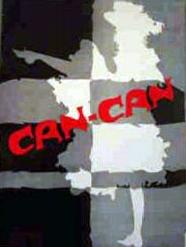
Version 2
Can-Can (1953-05-Schubert Theatre-Broadway)
Type de série: Original BroadwayThéâtre: Shubert Theatre (Broadway - Etats-Unis) Durée : 2 ans 1 mois 2 semaines Nombre : 892 représentationsPremière Preview : InconnuPremière : Thursday 07 May 1953Dernière : Saturday 25 June 1955Mise en scène : Abe Burrows • Chorégraphie : Michael Kidd • Producteur : Avec : Bailiff ... David Collyer
Registrar ... Michael Cavallaro
Policeman ... Michael Cavallaro
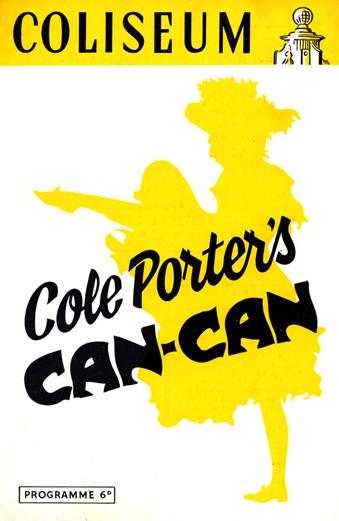
Version 3
Can-Can (1954-10-Coliseum Theatre-London)
Type de série: Original LondonThéâtre: Coliseum Theatre (Londres - Angleterre) Durée : Nombre : 394 représentationsPremière Preview : InconnuPremière : Thursday 14 October 1954Dernière : InconnuMise en scène : Abe Burrows • Chorégraphie : Michael Kidd • Producteur : Avec : Bailiff ... Bernard Quinn
Registrar ... Richard Lawrence
Policemen ... George Pastell

Version 4
Can-Can (1955-06-US Tour 1)
Type de série: US TourThéâtre: US Tour ( - Etats-Unis) Durée : Nombre : Première Preview : InconnuPremière : Saturday 25 June 1955Dernière : InconnuMise en scène : Abe Burrows • Chorégraphie : Michael Kidd • Producteur : Commentaires longs: Opened at the National Theatre in Washington, D.C.

Version 5
Can-Can (1957-01-Paper Mill Playhouse-Milburn)
Type de série: RevivalThéâtre: Paper Mill Playhouse (Milburn - Etats-Unis) Durée : Nombre : Première Preview : InconnuPremière : Tuesday 01 January 1957Dernière : InconnuMise en scène : Abe Burrows • Chorégraphie : Michael Kidd • Producteur : Avec : Judge Aristide Forestier ... Ted Scott
Claudine ... Ina Hahn
Hilaire Jussac ... Don Crabtree
Boris Adzinidzinadze ... Jack Harrold
La Mome Pistache ... Evelyn Page
Bailiff ... Donald Slagel
Policemen ... Fred Patrick, Laurence Stith
Judge Paul Barriere ... Robert Eckles
Court President, Henri Marceaux ... Peter J. Leeds
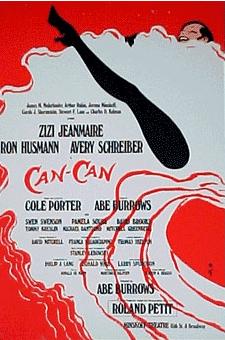
Version 6
Can-Can (1981-04-Minskoff Theatre-Broadway)
Type de série: RevivalThéâtre: Minskoff Theatre (Broadway - Etats-Unis)
Durée : Nombre : 16 previews - 5 représentationsPremière Preview : Thursday 16 April 1981Première : Thursday 30 April 1981Dernière : Sunday 03 May 1981Mise en scène : Abe Burrows • Roland Petit • Chorégraphie : Roland Petit • Producteur : Avec : Bailiff/Tabac Waiter/Chief Justice ... Joseph Cusanelli
Judge Paul Barniere ... David Brooks (i)
Court President/Monarchist/Prosecutor ... Tom Batten
Judge Aristide Forestier ... Ron Husmann
Claudine/Eve ... Pamela Sousa
Hilaire Jussac ... Swen Swenson
Boris Adzinidzinadze ... Avery Schreiber
Waiter/Jail Guard ... John Remme
La Mome Pistache ... Zizi Jeanmaire
Hercule ... Michael DantuonoCommentaires longs: This version featured a revised book by Abe Burrows.
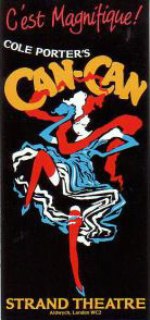
Version 7
Can-Can (1988-10-Strand Theatre-London)
Type de série: RevivalThéâtre: Novello Theatre (Londres - Angleterre) Durée : 2 mois 3 semaines Nombre : 102 représentationsPremière Preview : InconnuPremière : Wednesday 26 October 1988Dernière : Saturday 21 January 1989Mise en scène : Abe Burrows • David Taylor • Chorégraphie : Kenn Oldfield • Producteur : Avec : Donna McKechnie (La Mome Pistache), Milo O’Shea (Paul) , Bernard Alane (Aristide Forestiere), Jean-Michel Dadory (Boris), Janie Dee (Claudine)Commentaires : This was a newly scripted version by Julian More, incorporating additional songs written for other Cole Porter shows. However, in the words of Sheridan Morley “instead of an appallingly inadequate book by Abe Burrows we merely get a very disappointing one by Julian More”.

Version 8
Can-Can (2004-02-New-York City Center-New York) Encores! Concert
Type de série: ConcertThéâtre: New-York City Center (New-York - Etats-Unis) Durée : Nombre : 5 représentationsPremière Preview : InconnuPremière : Thursday 12 February 2004Dernière : Sunday 15 February 2004Mise en scène : Abe Burrows • Chorégraphie : Producteur : Avec : Judge Paul Barriere ... Eli Wallach
Judge Aristide Forestier ... Michael Nouri
Claudine ... Charlotte d'Amboise
La Mome Pistache ... Patti LuPone
Bailiff ... Dale Hensley
Court President, Henri Marceaux ... Michael X. Martin
First Policeman ... Josh Rhodes
Second Policeman ... Alex Sanchez
Third Policeman ... Thom Graham
Pierre ... Joshua JohnstonCommentaires longs: In the “Garden of Eden” ballet, Adam was played by Robert Wersinger, Eve was played by Charlotte d'Amboise, and the Snake was played by Caitlin Carter.

Version 9
Can-Can (2007-04-Lilian Baylis Theatre-London) Lost Musicals Concert
Type de série: ConcertThéâtre: Lilian Baylis Theatre (Londres - Angleterre) Durée : Nombre : 5 représentationsPremière Preview : InconnuPremière : Sunday 01 April 2007Dernière : Saturday 28 April 2007Mise en scène : Abe Burrows • Chorégraphie : Producteur : Avec : La Mome Pistache ... Valerie Cutko
Judge Aristide Forestier ... Christopher Dickins
Claudine ... Selina ChiltonCommentaires longs: "Lost Musicals" Performed April 1, 8, 15, 22, and 29. Directed Ian Marshall Fisher, starring Valerie Cutko (La Mome Pistache), Christopher Dickins (Judge Aristide Forestier), Selina Chilton (Claudine), Lara Denning, Sarah Applewood, Joanna Fell, Stewart Permutt, James Vaughan, Ahmet Ahmet, Christopher Stanton, David Phipps Davis, Alex Brown, Fabio Tassone.
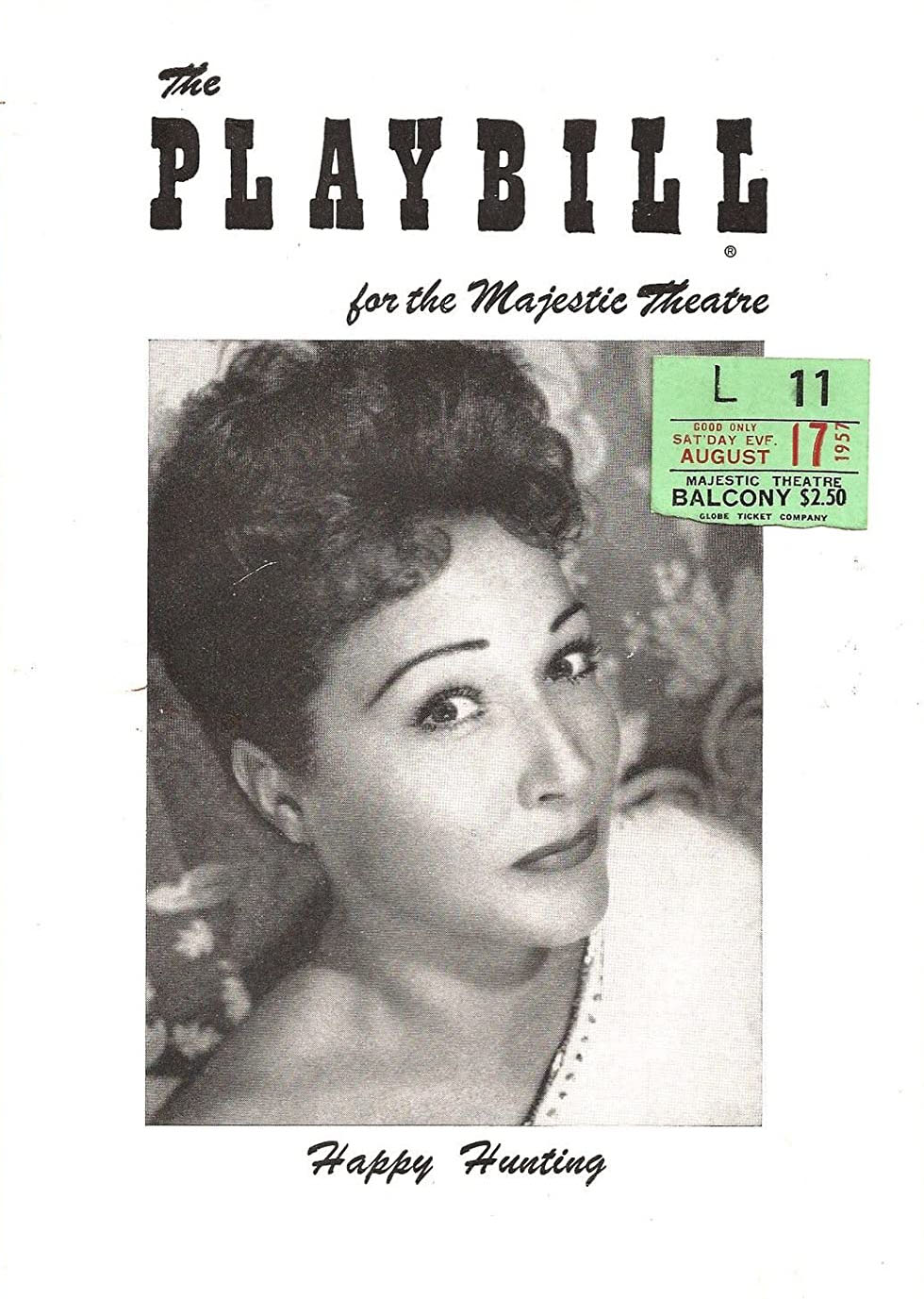
Version 10
Happy Hunting (1956-12-Majestic Theatre-Broadway)
Type de série: OriginalThéâtre: Majestic Theatre (Broadway - Etats-Unis) Durée : 11 mois 4 semaines Nombre : 412 représentationsPremière Preview : Thursday 06 December 1956Première : Thursday 06 December 1956Dernière : Saturday 30 November 1957Mise en scène : Abe Burrows • Chorégraphie : Producteur : Avec : Gordon Polk (Sanford Stewart Jr.), Olive Templeton (Mrs. Sanford Stewart Sr.), Mitchell M. Gregg (Joseph), Virginia Gibson (Beth Livingstone), Seth Riggs (Jack Adams), Gene Wesson (Harry Watson), Delbert Anderson (Charley), Ethel Merman (Liz Livingstone), Clifford Fearl (Sam), John Craig (Joe), George Martin (Freddy, Albert), Jim Hutchison (Wes, Terence), Estelle Parsons (Mary Mills), Robert C. Held (Dice Davis), Carl Nicholas (Bob Grayson), Mary Finney (Maud Foley), Mark Zeller (Police Sergeant), Leon Belasco (Arturo), Fernando Lamas (The Duke of Granada), Renato Cibelli (Count Carlos), Don Weissmuller (Waiter), John Leslie (Ship’s Officer, Mr. T.), Warren J. Brown (Barman), Florence Dunlap (Mrs. B.), Madeline Clive (Mrs. D.), Kelley Stephens (Mrs. L.), Eugene Louis (Tom), Moe (Daisy), Jay Velie (Mr. M.), Mara Landi (Margaret); Singers: Peggy Acheson, Marilynn Bradley, Deedy Irwin, Jane Johnston, Jean Kraemer, Mara Landi, Betty McGuire, Estelle Parsons, Noella Peloquin, Ginny Perlowin, Mary Roche, Kelley Stephens, Helene Whitney, Delbert Anderson, Edward Becker, Warren J. Brown, David Collyer, John Craig, Jack Dabdoub, Clifford Fearl, Robert C. Held, Carl Nicholas, Seth Riggs, Charles Rule, Mark Zeller; Dancers: Betty Carr, Alice Clift, Jane Fischer, Roberta Keith, Svetlana McLee, Patti Nestor, Wendy Nickerson, Fleur Rapp, Sigyn, Bob Bakanic, John Harmon, Jim Hutchison, Dick Korthaze, Eugene Louis, George Martin, Jim Moore, Lowell Purvis, Don Weissmuller, Roy Wilson
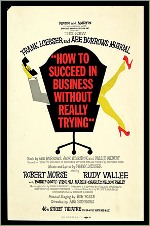
Version 11
How to Succeed ... (1961-10-Richard Rodgers Theatre-Broadway)
Type de série: OriginalThéâtre: Richard Rodgers Theatre (Broadway - Etats-Unis) Durée : 3 ans 4 mois 3 semaines Nombre : 3 previews - 1417 représentationsPremière Preview : Thursday 12 October 1961Première : Saturday 14 October 1961Dernière : Saturday 06 March 1965Mise en scène : Abe Burrows • Chorégraphie : Hugh Lambert • Producteur : Commentaires longs: Nominated for eight Tony Awards and won for Best Musical, Best Book, Best Direction of a Musical, Best Conductor and Musical Director, Best Producers of a Musical, Best Performance by a Leading Actor in a Musical for Robert Morse, and Best Performance by a Featured Actor in a Musical for Charles Nelson Reilly.[8] It also received the Best Musical Award from the New York Drama Critics Circle.
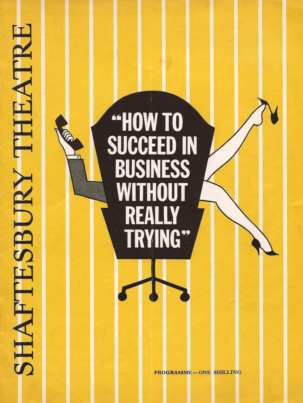
Version 12
How to Succeed ... (1963-03-Shaftesbury Theatre-London)
Type de série: Original LondonThéâtre: Shaftesbury Theatre (Londres - Angleterre) Durée : Nombre : 520 représentationsPremière Preview : Thursday 28 March 1963Première : Thursday 28 March 1963Dernière : InconnuMise en scène : Abe Burrows • Chorégraphie : Bob Fosse • Hugh Lambert • Producteur : Avec : Finch ... Warren Berlinger / J. B. Biggley ... Billy De Wolfe / Frump ... David Knight / Gatch ... Laurie Webb / Peterson ... Michael Billington / Johnson ... Roy Jameson / Jenkins ... Peter Dalton / Mathews ... Keith Galloway / Tackaberry ... David Henderson-Tate / Rosemary ... Patricia MichaelCommentaires longs: C'est avec ce musical que le Shaftesbury Theatre rénové a réouvert…